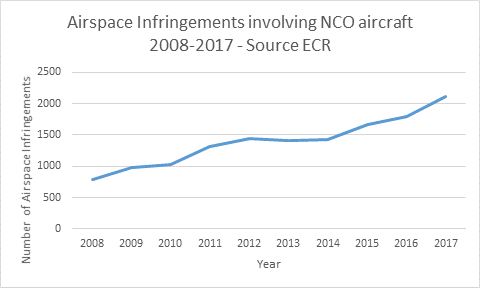AVOIDING AIRSPACE INFRINGEMENT
Current Situation: Risks and Consequences
Airspace in Europe is often very complex and avoiding airspace infringements is not always easy for even the most experienced of pilots. So careful planning is required to avoid airspace infringements. Unauthorised entry into controlled airspace increases the risk of an airprox or mid-air collision with other aircraft operating under air traffic control. Navigational errors are a major cause of airspace infringements, so care should always be taken to ensure that good navigational techniques are used at all times.
The number of airspace infringements has increased significantly over recent years and it is important that we all work to reverse this trend.

Source: EASA
This page suggests useful tips that will help to reduce the risk of airspace infringement and mid-air collision.
What can you do?
Before the Flight: Preparation is Key!
- Prepare and accurately plan your intended and alternate routes in advance!
- Airspace in the vicinity of airports may be complex with high traffic volumes, which increases the risk of mid-air collisions.
- Use approved, modern technologies that can support your flight planning, but keep practicing your basic pilot, navigation and dead reckoning skills.
- Gather all the necessary flight information such as NOTAMs, weather information, special zones activation, airport charts, airspace structure, etc. – even for local flights.
- Save the ATC and FIS frequencies you will need during your flight!
During Flight: Situation Awareness and Communication is Crucial!
- Know where you are at all times: approved navigation technologies and frequent radio communication significantly increase situational awareness when you’re in the air!
- Stay in contact with the Flight Information Service (FIS) / Air Traffic Control (ATC) or actively monitor the corresponding frequency.
- Stay visible: keep your transponder switched on to your assigned squawk (or the default 7000 code).
- The flight plan is your guide: follow your plan but be ready to adjust or change it in case of exceptional or unforeseen circumstances.
- If you know you have infringed controlled airspace, keep your transponder activated and contact FIS/ATC to inform them and request assistance. Never hesitate to communicate!
Use your navigational aids wisely in support of your situational awareness. Always ensure continued safe navigation is possible in case of failure of your electronic device by having an adequate back-up alternative ready for use. In case of using VFR charts as your (only) back-up, keep your basic pilot, navigation and dead reckoning skills current.
After the Flight: Lessons Learned
- Replay, review and debrief your flight.
- Share your experience with others and report any incident.
Last but not least, we encourage you to share this page to help others in the aviation community.
For more information you may contact: info@2-reg.com.